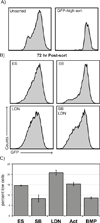TGF-β-superfamily signaling regulates embryonic stem cell heterogeneity: self-renewal as a dynamic and regulated equilibrium
- PMID: 23081664
- PMCID: PMC3528825
- DOI: 10.1002/stem.1252
TGF-β-superfamily signaling regulates embryonic stem cell heterogeneity: self-renewal as a dynamic and regulated equilibrium
Abstract
Embryonic stem cells dynamically fluctuate between phenotypic states, as defined by expression levels of genes such as Nanog, while remaining pluripotent. The dynamic phenotype of stem cells is in part determined by gene expression control and dictated by various signaling pathways and transcriptional regulators. We sought to define the activities of two TGF-β-related signaling pathways, bone morphogenetic protein (BMP) and Nodal signaling, in modulating mouse embryonic stem (ES) cell heterogeneity in undifferentiated culture conditions. Both BMP and Nodal signaling pathways were seen to be active in distinct Nanog subpopulations, with subtle quantitative differences in activity. Pharmacological and genetic modulation of BMP or Nodal signaling strongly influenced the heterogeneous state of undifferentiated ES cells, as assessed by dynamic expression of Nanog reporters. Inhibition of Nodal signaling enhanced BMP activity, which through the downstream target Id factors, enhanced the capacity of ES cells to remain in the Nanog-high epigenetic state. The combined inhibition of Nodal and BMP signaling resulted in the accumulation of Nanog-negative cells, even in the presence of LIF, uncovering a shared role for BMP and Nodal signaling in maintaining Nanog expression and repression of differentiation. These results demonstrate a complex requirement for both arms of TGF-β-related signaling to influence the dynamic cellular phenotype of undifferentiated ES cells in serum-based media, and that differing subpopulations of ES cells in heterogeneous culture have distinct responses to these signaling pathways. Several pathways, including BMP, Nodal, and FGF signaling, have important regulatory function in defining the steady-state distribution of heterogeneity of stem cells.
Copyright © 2012 AlphaMed Press.
Conflict of interest statement
The authors declare no conflict of interest.
Figures







References
-
- Smith AG. Embryo-derived stem cells: of mice and men. Annu Rev Cell Dev Biol. 2001;17:435–462. - PubMed
-
- Ohtsuka S, Dalton S. Molecular and biological properties of pluripotent embryonic stem cells. Gene Ther. 2008;15:74–81. - PubMed
-
- Suzuki A, Raya A, Kawakami Y, et al. Maintenance of embryonic stem cell pluripotency by Nanog-mediated reversal of mesoderm specification. Nat Clin Pract Cardiovasc Med. 2006;3(Suppl 1):S114–S122. - PubMed
-
- Chambers I, Silva J, Colby D, et al. Nanog safeguards pluripotency and mediates germline development. Nature. 2007;450:1230–1234. - PubMed
Publication types
MeSH terms
Substances
Grants and funding
LinkOut - more resources
Full Text Sources
Research Materials

